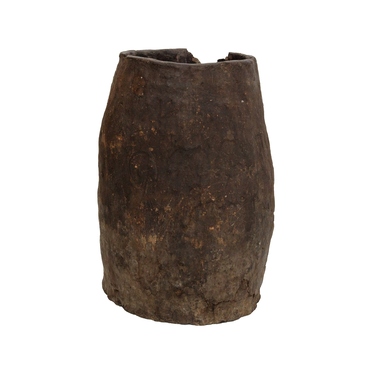The museum purchased a hand-spun potter’s wheel from Vladimir Makarov, a resident of Saransk, in 1973.
The machine is a bench: a board on four inserted legs, paired with crossbars. At the working end of the board, a hole is made through which an iron rod runs vertically to the bottom crossbar, the “leg” of the bench. The rod is inserted into a special recess of the crossbar and serves as a rotation axis for a wooden wheel.
In most cases the bearers of pottery traditions on the territory of Mordovia were not Mordovians, but the descendants of Russian potters who moved here in the 17–19 centuries. Archaic features of pottery production were preserved here to a greater extent than in the areas populated mainly with ethnic Russians. For example, the hand-spun wheel was used by craftsmen all over the Mordovian region up until the 1920s.
Operating such a machine was not complicated. The master sat astride the bench, kneaded a piece of clay into a cake — the base of the future pot, which he tapped with his fist to the center of the circle sprinkled with ash. Then he gradually began to build up the walls of the vessel up to the necessary height. For this purpose, the 3–4 centimeters thick rolled out coils of clay were put spirally on top of each other. Rotating the wheel with one hand, the master smoothed the coils with the other, flattening them and smoothing with a wooden knife.
About 15 coils were needed to make a large 38-40 centimeters high vessel. Continuing to rotate the wheel, the master pressed to the upper edge of the pot a wet rag — “mokrusha”, “helper” — and bent it outward, simultaneously smoothing it out. The resulting pot weighed 8-9 kilograms. Having given the product the necessary shape, the potter decorated it with an ornament, then cut it off with a special thread or wire and left it to dry for 3-4 days. One potter could make about 16 to 17 big and 20 to 30 medium-sized pots in one day.
Such a method of making utensils was called “coiling” by the masters. It was known on the territory of modern Mordovia since the Neolithic period and is widespread in the archaeological layers of the later cultures — Fatyanovskaya and Srubnaya.
The machine is a bench: a board on four inserted legs, paired with crossbars. At the working end of the board, a hole is made through which an iron rod runs vertically to the bottom crossbar, the “leg” of the bench. The rod is inserted into a special recess of the crossbar and serves as a rotation axis for a wooden wheel.
In most cases the bearers of pottery traditions on the territory of Mordovia were not Mordovians, but the descendants of Russian potters who moved here in the 17–19 centuries. Archaic features of pottery production were preserved here to a greater extent than in the areas populated mainly with ethnic Russians. For example, the hand-spun wheel was used by craftsmen all over the Mordovian region up until the 1920s.
Operating such a machine was not complicated. The master sat astride the bench, kneaded a piece of clay into a cake — the base of the future pot, which he tapped with his fist to the center of the circle sprinkled with ash. Then he gradually began to build up the walls of the vessel up to the necessary height. For this purpose, the 3–4 centimeters thick rolled out coils of clay were put spirally on top of each other. Rotating the wheel with one hand, the master smoothed the coils with the other, flattening them and smoothing with a wooden knife.
About 15 coils were needed to make a large 38-40 centimeters high vessel. Continuing to rotate the wheel, the master pressed to the upper edge of the pot a wet rag — “mokrusha”, “helper” — and bent it outward, simultaneously smoothing it out. The resulting pot weighed 8-9 kilograms. Having given the product the necessary shape, the potter decorated it with an ornament, then cut it off with a special thread or wire and left it to dry for 3-4 days. One potter could make about 16 to 17 big and 20 to 30 medium-sized pots in one day.
Such a method of making utensils was called “coiling” by the masters. It was known on the territory of modern Mordovia since the Neolithic period and is widespread in the archaeological layers of the later cultures — Fatyanovskaya and Srubnaya.



